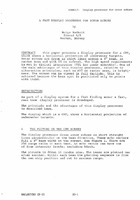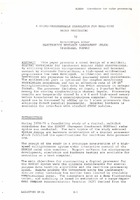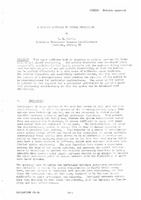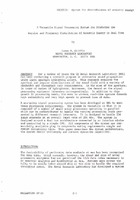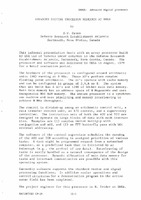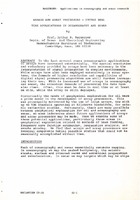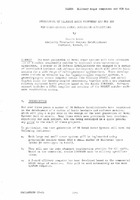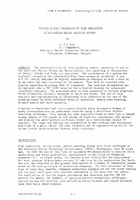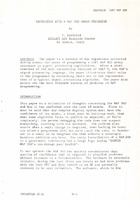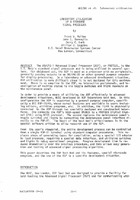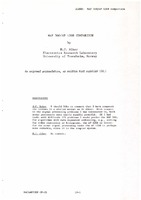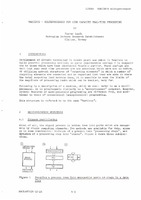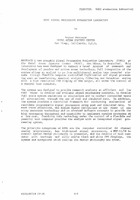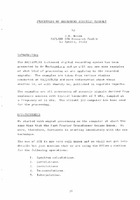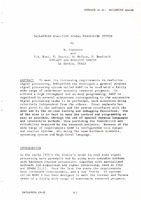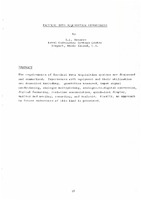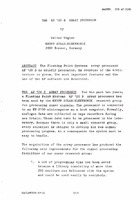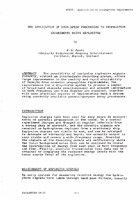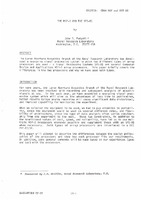Browsing Reprints by Subject "Computer systems"
Now showing items 1-20 of 23
-
A fast display processor for sonar echoes
(NATO. SACLANTCEN, 1979/12)This paper presents a display processor for a CRT, which shows a horizontal projection of underwater targets. Sonar echoes are drawn as short lines across a 50 beam, in random scan and with 50 Hz refresh. The high speed ... -
A micro-programmable correlator for real-time radar processing
(NATO. SACLANTCEN, 1979/12)This paper presents a novel design of a multibit, digital correlator for incoherent scatter radar observations. By utilizing bit-slice microprocessor elements and internal control by microcode instructions, a high-speed ... -
A modular approach to signal processing
(NATO. SACLANTCEN, 1979/12)This paper outlines work in progress on modular systems for beamforming and signal processing. The modules described were developed using commercially available digital L.S.I circuits and the emphasis during development ... -
A versatile signal-processing system for producing the angular and frequency distribution of acoustic energy in real time
(NATO. SACLANTCEN, 1979/12)For a number of years the US Naval Research Laboratory (NRL) has been conducting a research program in underwater sound propagation using large aperture hydrophone arrays. This research requires the spectral and angular ... -
Advanced digital processor research at DREA
(NATO. SACLANTCEN, 1979/12)This informal presentation deals with an array processor built by ESE Ltd of Toronto under contract to the Defense Research Establishment Atlantic, Dartmouth, Nova Scotia, Canada. The processor and software was delivered ... -
Arrays and array processors: future real time applications in oceanography and sonar
(NATO. SACLANTCEN, 1979/12)In the last several years oceanographic applications of arrays have increased substantially. The spatial resolution and redundancy provided by arrays have been necessary in the interpretation of signal propagation in complex ... -
Development of military ARGUS computers and MOD bus for close-coupled signal processing applications
(NATO. SACLANTCEN, 1979/12)The next generation of Naval sonar systems will make extensive use of flexible programable modules to implement signal-processing algorithms. A number of UK Defence Establishments are engaged in a series of coordinated ... -
Digital signal processing of high resolution within-pulse sector scanning sonars
(NATO. SACLANTCEN, 1979/12)The characteristics of three scanning sonars, presently in use at the Admiralty Marine Technology Establishment, and operating at frequencies of 300kHz, 150kHz and 75kHz are described. The performance of a system for ... -
Experience with a MAP 300 array processor
(NATO. SACLANTCEN, 1979/12)The paper is a summary of the experience collected during almost two years of programming a CSPI MAP 300 array ' processor in signal processing applications. After a short overview of the most interesting features of SNAP ... -
Laboratory utilization of a standard signal processor
(NATO. SACLANTCEN, 1979/12)The AN/UYS-l Advanced Signal Processor (ASP), or PROTEUS, is the U.S. Navy's standard signal processor and is being utilized in several systems. For shipboard use, the ASP is used as a processor with no peripherals, generally ... -
MAP 300/AP 120B comparison
(NATO. SACLANTCEN, 1979/12) -
Martinus - multiprocessor for high capacity real-time processing
(NATO. SACLANTCEN, 1979/12)Development of circuit technology in recent years now makes it feasible to build powerful processing machines at quite considerable savings - in comparison to those which have been considered feasible earlier. These savings ... -
NOSC signal processing evaluation laboratory
(NATO. SACLANTCEN, 1979/12)A new acoustic Signal Processing Evaluation Laboratory (SPEL) at the Naval Ocean Systems Center (NOSC), San Diego, is described. This laboratory has been designed to support a broad program of research and development of ... -
Overview of the ADPS signal processor
(NATO. SACLANTCEN, 1979/12) -
Processing of broadband acoustic signals
(NATO. SACLANTCEN, 1972/05) -
SACLANTCEN real-time signal processing system
(NATO. SACLANTCEN, 1979/12)To meet its increasing requirements in real-time signal processing, SACLANTCEN has developed a general purpose. signal processing system called WARP to be uS.ed with a fairly wide range of underwater acoustic research ... -
Tactical data acquisition experiences
(NATO. SACLANTCEN, 1972/05)The requirements of Tactical Data Acquisition systems are discussed and summarized. Experiences with equipment and their utilization are described including : quantities measured, input signal conditioning, analogue ... -
The AP-120B array processor
(NATO. SACLANTCEN, 1979/12)The Floating Point Systems array processor AP 120 B is briefly presented. An overview of the architecture is given. The most important features and the use of the AP software are described -
The application of high-speed processors to propagation experiments using explosives
(NATO. SACLANTCEN, 1979/12)The possibility of analysing explosive signals directly, without an intermediate recording system, offers large improvement~ in the quality and rapid availability of results from acoustic propagation experiments. The ... -
The MPS-3 and the SPS-81
(NATO. SACLANTCEN, 1979/12)The Larqe Aperture Acoustics Branch of the Naval Research Laboratory has developed a sea-qoinq signal processinq system in which two different types of array processors are used - a Signal Processing Systems SPS-81 and ...
